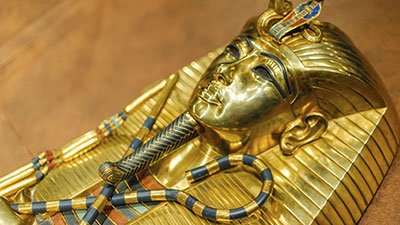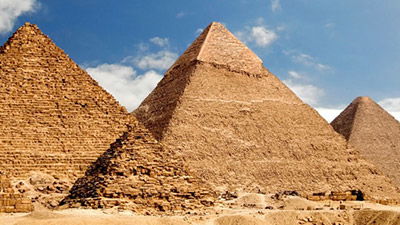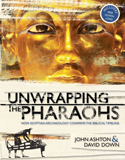
Will the Real Shishak Please Stand Up?
Who did Thutmose III fight at Megiddo, and what does that battle have to do with plundering Jerusalem? Dr. Elizabeth Mitchell, AiG–U.S., explains.
The following question appeared on Ken Ham’s Facebook page. We thought it was a topic that would interest others, so we’re offering an expanded answer here. Thanks to the author for the question. This answer deals with the original question first and then explores further the identity of Shishak.
I got the New Answers Set for Christmas this year and was reading the chapter in Book 2 about Egyptian chronology. But I noticed something in it that confused me. According to the new timeline in there, Thutmose III was Shishak, who plundered Jerusalem. Now correct me if I’m wrong, but according to Egyptian sources, when Thutmose III invaded Palestine, he fought the Canaanites, not the Israelites, at the Battle of Megiddo. It just doesn’t add up in my mind. I loved the Creation Museum and can’t wait to see Ark Encounter. God bless.
Who Did Thutmose III Fight at Megiddo, and What Does That Battle Have to Do with Plundering Jerusalem?
Thutmose III of Egypt’s eighteenth dynasty, identified as the Shishak of the Bible, vigorously pursued his goal of extending Egypt’s frontiers by conquering 119 cities in the land of Canaan, as described on the wall of his chapel at the temple of Karnak. The Bible tells us Shishak captured the fortified towns of Judah (2 Chronicles 12:4), which would have comprised a portion of his wide-ranging conquests. The Battle of Megiddo was key to consolidating Thutmose’s victories. Inscriptions at Karnak call his enemy at Megiddo “that wretched enemy of Kadesh.” Apparently, the ruler of Kadesh led a coalition of forces to defend the strategically important pass at Megiddo—a narrow pass and a popular place for military encounters. The Karnak inscriptions say Thutmose III had gathered allies of every foreign country loyal to Egypt for this engagement, including some from far away Syria. Shishak’s allies are also mentioned in 2 Chronicles 12:3, and that list includes Lubim (Libyans), Sukkiim, and Kushites (Ethiopians).
The larger context of Thutmose III’s invasion is a logical backdrop for the fate of Judah and Jerusalem.
The larger context of Thutmose III’s invasion is a logical backdrop for the fate of Judah and Jerusalem. Although the Bible does not specifically mention this particular battle at Megiddo, it seems unlikely the Egyptian pharaoh would have needed to bring along a host of foreign allies to assist him only in defeating Rehoboam’s piece of Canaan, weakened as it was by the recent split in Solomon’s huge kingdom. And if Judah had been the sole focus of the expedition, it seems equally unlikely that the desire of this multinational army for booty would have been satisfied by leaving Jerusalem intact. Of course, this is only conjecture, and whether Judah was the sole focus for the invasion or not creates no biblical discrepancy.
Within this context of Egyptian invasion, the Bible focuses on God using Egypt to discipline the people of Judah. God left Judah open to invasion because “they had transgressed against the Lord
” (2 Chronicles 12:2). Scripture tells us Shishak “took the fortified cities of Judah and came to Jerusalem
” (2 Chronicles 12:4). Rehoboam repented after God’s prophet explained, “Thus says the Lord: ‘You have forsaken Me, and therefore I also have left you in the hand of Shishak’
” (2 Chronicles 12:5). Shishak then stripped Jerusalem’s wealth but left it standing. The unmentioned battle of Megiddo would likely have occurred in the middle of verse 4—after the fortified cities of Judah fell and before Shishak parked his army at Jerusalem’s gates.
The Bible gives no indication that Shishak attacked (or didn’t attack) the Northern Kingdom of Israel, at that time ruled by Jeroboam. However, Shishak may well have spared Jeroboam’s land since Jeroboam, according to 1 Kings 11:40, had taken refuge with Shishak in Egypt until Solomon died. It wouldn’t make much sense for Shishak, who had many allies, to attack Jeroboam’s newly obtained kingdom, which would be far more useful as an ally and buffer state against northern incursions.
We don’t know for certain who “that wretched enemy of Kadesh” coordinating Egypt’s enemies at Megiddo was. It could have been Judah’s king, Rehoboam. The word kadesh may be equivalent to the Hebrew word for “holy” (qodesh), which is used in a number of Old Testament references to Jerusalem, “the holy city
” (Nehemiah 11:1; Isaiah 48:2, 52:1; Daniel 9:24). So it is possible Thutmose III fought and defeated Rehoboam’s army at Megiddo. We cannot, however, know the identity of the discomfited enemy with certainty.
If we are correct in identifying Thutmose III with Shishak, then by comparing the Karnak inscriptions with the details in the Bible, we can follow Thutmose III from his victory at Megiddo to the gates of Jerusalem. Shishak did not destroy Jerusalem but instead confiscated the treasures in its temple and palace. The Karnak carvings depicting the loot Thutmose brought back to Egypt show 300 gold shields, doors overlaid with gold, and an assortment of utensils suitable for temple worship. Comparing the Karnak record to the Bible’s description of what Shishak took reveals remarkable similarity. 2 Chronicles 12:9 states, “So Shishak king of Egypt came up against Jerusalem, and took away the treasures of the house of the Lord and the treasures of the king’s house; he took everything. He also carried away the gold shields which Solomon had made.
” We know from 1 Kings 10:17 that Solomon had made 300 such gold shields.1 We also find record of the gold-overlaid doors in 1 Kings 6:32. The Karnak description does not identify the city from which these trophies came—only that they were brought to Egypt after Thutmose’s victory at Megiddo.
Thus, although Shishak did not attack Jerusalem, he had conquered many of Judah’s cities. Whether or not Rehoboam’s army was fighting at Megiddo we cannot be certain, but since Shishak had conquered many of Judah’s fortified cities, Rehoboam probably felt himself fortunate to get off with his throne intact, buying Jerusalem’s safety with temple gold and getting back in God’s good graces too.
Will the Real Shishak Please Stand Up?
So how do we know Shishak and Thutmose III were one and the same person? To be fair, we don’t. But based on the archaeological evidence presently available, we agree with David Down and John Ashton (see Unwrapping the Pharaohs, The Greatest of All the Pharaohs) that Thutmose III is the most likely candidate. The chronological analysis in The New Answers Book 2 details how the placement of Thutmose in this spot is in accord with what we know of biblical, Hittite, Assyrian, and Egyptian chronology. Certainly the matching loot depicted at Karnak strengthens the case. What we do know is that whoever the correct Shishak is, his correct place in history and history’s timeline must match information provided in the Bible and the Bible’s chronology.
There are other candidates in the running. David Rohl, for instance, in his reconstruction of Egyptian chronology, suggests Ramses II was the biblical Shishak. This Ramses (“the Great”) was another of Egypt’s warrior pharaohs with his share of inscriptions and monuments—including the broken colossus that inspired Shelley’s “Ozymandias” (the poem that inspired my interest in Egyptian history in the first place, incidentally). His treaty with the Hittite Hattusilis III is recorded at Karnak, but we have no way of determining its date. Traditional chronology had assigned Ramses II a date to make him the pharaoh of the Exodus—a position that fails chronologically, archaeologically, biblically, and historically. But Rohl’s reassignment of this Ramses to the time of Rehoboam creates other problems in the effort to align the chronologies of Egypt with the rest of the ancient world. Rohl, an Egyptologist who treats the Bible as reliable history but not an infallible source, has provided a great deal of information and thoughtful analysis in his book, Pharaohs and Kings: A Biblical Quest, yet he wrote (page 144) that this latter part of Egypt’s history still needed additional research and revision.
Isaac Newton not only laid the foundation for much of our scientific understanding but also studied ancient history and biblical chronology. He lacked access to the archaeological discoveries we have today, but he believed the Bible and considered it the standard by which chronological possibilities should be judged. Newton’s work was published posthumously and is now available to us, thanks to the efforts of Larry and Marion Pierce, in Newton’s Revised History of Ancient Kingdoms. Sources for information about ancient Egyptian chronology are fragmentary, and much has been based on a compilation by Manetho, a third century BC Egyptian priest. Newton saw the inconsistencies of Manetho’s work and believed that Herodotus’s interpretation of Egyptian history provided a reliable yardstick. Newton believed Shishak was Sesostris I. Like other warrior pharaohs, Sesostris had campaigned in the Levant, and Herodotus—travelling in the fifth century BC—saw some of his pillars and inscriptions in Syria. Herodotus drew his information about Egypt from the Egyptian priests, and Newton tried to synchronize that information about Egyptian chronology with what was known of Greek history (another chronological quagmire) and, of course, the Bible. Newton constructed an Egyptian timeline that placed Sesostris at the correct time to be Shishak and attack Rehoboam in the tenth century BC. However, archaeological material not yet discovered in Newton’s day strongly suggests Sesostris I belongs about seven centuries earlier and ironically may well have been the pharaoh who employed Joseph.
Notice the most important consideration in trying to determine the identity of Shishak is to determine who ruled Egypt at the time Rehoboam ruled Judah. The Bible is the one completely reliable yardstick. The three candidates mentioned above all made it into consideration because the historians who proposed them found reasons to rebuild Egypt’s chronology and—in the case of both Down and Rohl—found it completely different from the traditional chronologies that have burdened and confused historians, archaeologists, students of the Bible, and even children since the nineteenth century. With each turn of the spade, there is the possibility of discovering additional data to straighten out the Egyptian timeline, but all acceptable possibilities must accord with the Bible. (Interestingly, Rohl constructs much of his revision without reliance on Scripture and still finds traditional views must be revised.)
Will the Wrong Shishak Please Sit Down?
So how did the chronological confusion come about? Jean Champollion, the brilliant translator of the Rosetta Stone, unwittingly gave support to inconsistent chronology when he erroneously identified Pharaoh Shoshenq as the Shishak of the Bible. Champollion found an inscription about Shoshenq, founder of the 22nd Dynasty, at the temple of Karnak. Because the names sound similar, Champollion assumed that Shoshenq was Shishak. Then, with the biblical date for Rehoboam as a starting point, chronologists used Manetho’s list to outline the next three centuries of Egyptian history.
Many Bible scholars have trusted traditional chronology even when it disputes the Old Testament.
Manetho’s list is problematic enough, being full of discrepancies, duplications, and overlaps, but the starting point Champollion thought he’d found was incorrect. The two problems with identifying Shoshenq as Shishak involve military strategy and phonics. According to the Karnak inscriptions, Shoshenq attacked the northern part of Israel, not Rehoboam’s Jerusalem or Judah. As we said earlier, Jeroboam was Shishak’s friend and probably his ally. If Shoshenq were Shishak, then Shoshenq attacked his friend and ignored his enemy. Furthermore, the phonetics of these two pharaohs’ names only sound similar in transliterated form, not in the original languages.
Because of this faulty identification of Shoshenq with Shishak, Egyptologists ignored the rest of the biblical facts relating to the geography and characters involved. Then, because dates determined by combining the Shoshenq-Shishak error with a misplaced acceptance of Manetho’s work almost magically match traditional information about the confusing Third Intermediate Period, many Bible scholars have trusted traditional chronology even when it disputes the Old Testament.
We should take a lesson from this bit of history. Champollion, with the best of intentions, a brilliant mind, a track record for great discoveries, and a belief in biblical history, stumbled. He began with the Bible and developed what seemed to be a perfect match. But when further analysis produced discrepancies with the Bible, the biblical Egyptologists of the time dropped the ball. They held on to their original interpretations of the evidence even when it forced clear discrepancies with the Bible.
In creation ministry, we also sometimes discover that models or arguments once popular among Christians, when examined more closely, actually conflict with new discoveries or, even more importantly, with Scripture. This website even maintains a section of arguments creationists should avoid. All evidence needs to be viewed through biblical glasses. We need to always be like the Bereans, who were commended because they “searched the Scriptures daily
” (Acts 17:11), measuring all we “know” according to God’s Word and not being too stubborn to change any unscriptural ideas we may have.
Footnotes
- 1 Kings 1:16 states that King Solomon had made 200 large shields of gold, and verse 17 shows that he made 300 smaller shields of gold. It is these 300 shields that may be depicted at Karnak.
Recommended Resources

Answers in Genesis is an apologetics ministry, dedicated to helping Christians defend their faith and proclaim the good news of Jesus Christ.
- Customer Service 800.778.3390
- © 2025 Answers in Genesis






